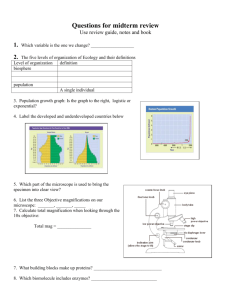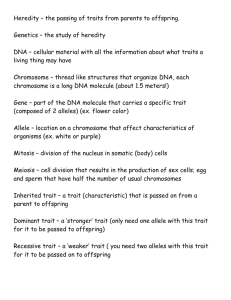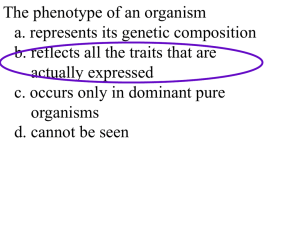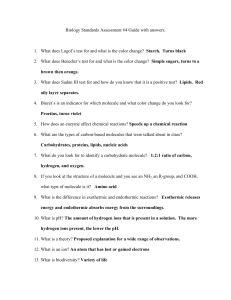Biology Fall Semester Study Guide
advertisement
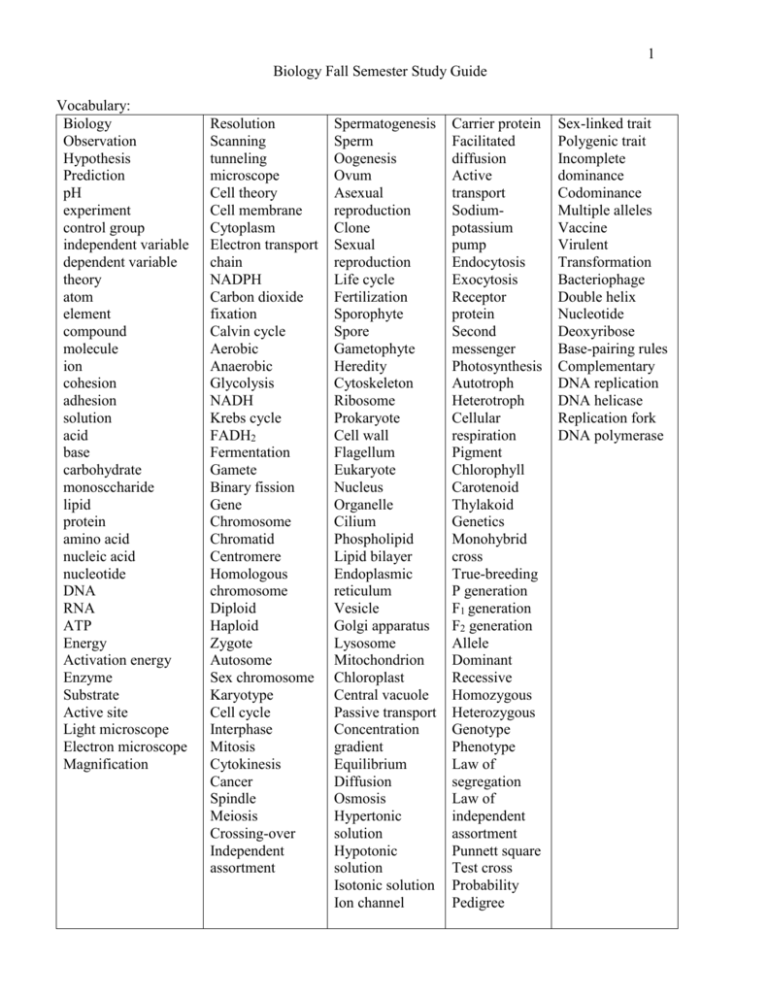
1 Biology Fall Semester Study Guide Vocabulary: Biology Observation Hypothesis Prediction pH experiment control group independent variable dependent variable theory atom element compound molecule ion cohesion adhesion solution acid base carbohydrate monosccharide lipid protein amino acid nucleic acid nucleotide DNA RNA ATP Energy Activation energy Enzyme Substrate Active site Light microscope Electron microscope Magnification Resolution Scanning tunneling microscope Cell theory Cell membrane Cytoplasm Electron transport chain NADPH Carbon dioxide fixation Calvin cycle Aerobic Anaerobic Glycolysis NADH Krebs cycle FADH2 Fermentation Gamete Binary fission Gene Chromosome Chromatid Centromere Homologous chromosome Diploid Haploid Zygote Autosome Sex chromosome Karyotype Cell cycle Interphase Mitosis Cytokinesis Cancer Spindle Meiosis Crossing-over Independent assortment Spermatogenesis Sperm Oogenesis Ovum Asexual reproduction Clone Sexual reproduction Life cycle Fertilization Sporophyte Spore Gametophyte Heredity Cytoskeleton Ribosome Prokaryote Cell wall Flagellum Eukaryote Nucleus Organelle Cilium Phospholipid Lipid bilayer Endoplasmic reticulum Vesicle Golgi apparatus Lysosome Mitochondrion Chloroplast Central vacuole Passive transport Concentration gradient Equilibrium Diffusion Osmosis Hypertonic solution Hypotonic solution Isotonic solution Ion channel Carrier protein Facilitated diffusion Active transport Sodiumpotassium pump Endocytosis Exocytosis Receptor protein Second messenger Photosynthesis Autotroph Heterotroph Cellular respiration Pigment Chlorophyll Carotenoid Thylakoid Genetics Monohybrid cross True-breeding P generation F1 generation F2 generation Allele Dominant Recessive Homozygous Heterozygous Genotype Phenotype Law of segregation Law of independent assortment Punnett square Test cross Probability Pedigree Sex-linked trait Polygenic trait Incomplete dominance Codominance Multiple alleles Vaccine Virulent Transformation Bacteriophage Double helix Nucleotide Deoxyribose Base-pairing rules Complementary DNA replication DNA helicase Replication fork DNA polymerase 2 Biology Fall Semester Study Guide Major Semester Exam Concepts: Chapter 1 1.) 2.) 3.) 4.) 5.) 6.) 7.) 8.) 9.) 10.) 11.) 12.) 13.) 14.) 15.) 16.) 17.) 18.) What are the first and last things to do before entering and leaving the lab area? Give 3 examples example of how humans maintain homeostasis. Explain the difference between independent and dependent variables. What is meant by a controlled experiment? Why is it important to only test one variable at a time? What is biology? What is the best graph to use in representing measured data? Categorical data? Percentage data? Be able to interpret information from line graphs, bar graphs, pie charts, and data tables. Explain the difference between a scientific theory and a hypothesis. What is the control in an experiment? Explain what to do if an experiment gives an unexpected result. What are the metric units on a meter stick? A ruler? A graduated cylinder? A balance? What type of microscope would be used to view living samples? Explain the difference between quantitative and qualitative research. Describe the relationship between cells and organisms. List the 4 characteristics that all living things share. Why are observations critical to the scientific process? How do biologists test hypotheses? Explain scientific theories and list one reason why they may be altered or replaced. Chapter 2 1.) 2.) 3.) 4.) 5.) 6.) 7.) 8.) What type of bond is responsible for the properties of water? What is an atom? …an element? …a compound? …a molecule? How are compounds and mixtures different? List the four carbon-based molecules and their associated building blocks. What element is found in all organic molecules? What kind of special bonds link amino acids? Why are lipids important? Why are enzymes considered catalysts, and what factors control the efficiency of enzyme function? Chapter 3 1.) 2.) 3.) 4.) 5.) 6.) 7.) 8.) 9.) 10.) 11.) 12.) 13.) What is the main difference between eukaryotic and prokaryotic cells? Where would you find water with respect to the cell? How are cilia and flagella similar in function? If rice swells after sitting in water, explain what caused the swelling. Active and passive transport are ways in which the cell works to maintain what? List one example of osmosis. A cell placed in a hypertonic solution will do what? What if it was placed in a hypotonic solution? Which organelle is responsible for producing energy in the cell? What are 2 functions of phospholipids in the cell membrane? Why are lipids important? What organelle synthesizes protein? Draw a picture of the phospholipid bilayer. What are three things found in plant cells that are not found in animal cells? Chapter 4 1.) 2.) 3.) Write the equation for photosynthesis and explain the reaction in words. Write the equation for cellular respiration and explain how respiration could be measured in humans. Where does glycolysis happen (specifically inside the cell) and how many ATP molecules are generated per molecule of glucose? 3 4.) 5.) 6.) 7.) 8.) 9.) Draw and label the parts of a chloroplast and include thylakoid and stroma. Where do light dependent reactions take place? …the dark reactions take place? Why do plants look green? How is ATP stored? What factors affect the rate of photosynthesis? ATP is most efficiently produced during what process? Chapter 5 1.) 2.) 3.) Draw and label the stages of mitosis in the correct order. Why is mitosis important for multicellular organisms? If plants reproduce via vegetative propagation, will the offspring be genetically identical to the parent plant or genetically unique? List the advantages of asexual reproduction. List the advantages of sexual reproduction. During what phase of mitosis do chromosomes become visible? What is dividing during mitosis? Draw the process of binary fission. DNA is replicated during what phase of the cell cycle? 4.) 5.) 6.) 7.) 8.) 9.) Chapter 6 1.) 2.) 3.) 4.) Explain the difference between genotype and phenotype. In a testcross what two individuals are crossed? What is the result of meiosis? What is the result of mitosis? In a cross between a homozygous dominant parent and a heterozygous parent, predict the genotypic and phenotypic ratios in the offspring. Explain the difference between homozygous and heterozygous traits. Draw an illustration of crossing over. What is nondisjunction? During meiosis, in which phase do homologous chromosomes line up in the middle of the cell? What is the difference between haploid and diploid chromosome number? How many chromosomes are in human somatic cells? …in human gametes? Male and female gametes combine to form what? 5.) 6.) 7.) 8.) 9.) 10.) 11.) Chapter 7 1.) 2.) a. b. c. d. e. Explain sex linked traits. How would the following be represented be represented in a pedigree? males exhibiting a trait males without the trait females exhibiting a trait females without the trait female carriers of the trait Chapter 8 1.) 2.) 3.) 4.) 5.) 6.) 7.) Draw an example of inversion. What is deletion? Draw a DNA molecule and explain the structure. What is genetics? What are the parts of a DNA molecule? According to base pairing rules cytosine pairs with what and thymine pairs with what? Explain DNA replication.
